April 20, 2022, by Kathryn Steenson
Mansfield and the Waste of Water
In 1899, the Nottinghamshire town of Mansfield was causing a certain amount of confusion and alarm.
The population was just under 16,000 according to the 1891 census, was predicted to be about 18,500 to 20,000 by 1901. The problem facing engineers George & F.W. Hodson was that they were all using a suspiciously large quantity of water. In Nottingham, Sheffield, and Leicester, each resident was using a respectable 20 gallons of water day. In Mansfield, it was 25 gallons per day. It could have been that the people of Mansfield enjoyed deeper and more frequent baths, or that they flushed the toilets with wanton disregard for the reservoir levels. Or, it could be that there was a massive and unidentified leak somewhere in the brand-new water system.
This is one of those types of records that either wouldn’t be produced today, or certainly would not be made public. It’s a fairly simple engineering report, laying out the best estimates of the situation, the probable cause, and the solution. What makes it unique and worthy of being in the Special Collections is that the photographs and newspaper articles are the originals that have been glued in.
The new pumping station at Rainworth had only been opened in 1897 in a ceremony attended by the great and good. Newspaper reports from the Mansfield and North Notts Adviser gushed over the marvels of modern engineering: clean water supplied, electric lighting, and the boom in the coal mining industry. The engine was officially ‘opened’ by smashing a bottle of champagne against it, and then commenced speeches, lunch, and a live orchestras to provide some entertainment. There was a slight faux-pas, in that one attendee was referred to as ‘Mister’ on the toast list whereas the other (untitled) delegates were given the term ‘Esquire’, which is one of those charming little anecdotes which underscores how dreadfully fusty and formal the whole afternoon was.
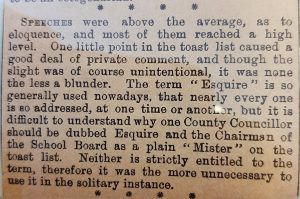
“Esquires me, what did you just call me?”. Extract from a newspaper article about the opening ceremony.
This is not to say that the achievements weren’t worth celebrating: the surveyor at Mansfield Woodhouse was the only representative of that Council to attend as they had vehemently opposed the water supply and sanitation plans, and the speeches made reference to the considerable persuasion some officials needed to support the scheme. Although the engineers’ report states that ‘supply every year becomes more of a “necessity”‘, in truth there were plenty of properties not connected to mains water, and an awful lot of people who considered spending money on providing clean water and sewerage an appalling waste of money.
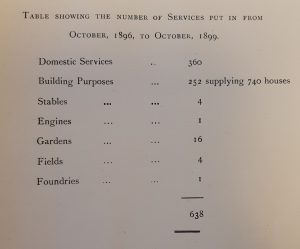
Table showing the numbers of domestic and commercial properties connected to the town’s water supplies from 1896 to 1899.
It was, then, a little embarrassing that within three years of opening, the Waterworks built to last 30 years was already at 80% capacity and rising. Engineers spent days monitoring the reservoir levels hourly and concluded there was a massive leak as there was a surprising amount of water being used at odd times, such as 4am on a Sunday morning. One-third of the water “used” was simply trickling away in a large leak somewhere in the underground pipes, possibly caused by the encroaching colliery works. And it was expensive: expensive to use the coal-fired pumps to raise reservoir levels; expensive to replace machinery and parts due to increased wear and tear; and it would be especially expensive to build a whole new waterworks when the existing one hit maximum capacity.

Readings taken of reservoir water levels to prove an underground water leak, which would not be visible through normal inspection
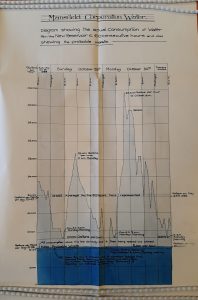
The chart proving the leak. The light blue shows demand, and everything in dark blue is water escaping from the system.
The water supply system, not just in Mansfield but everywhere, had been built with little consideration given to how damage to underground pipes might be detected, beyond the earth caving in or water erupting into a geyser. Fortunately a method was developed (and is described in the pamphlet), but even today the rate that water leaks from the supply lines causes some concern, though the reasons are usually lack of maintenance and an aging system, rather than nearby mines.
The ‘Report on the water consumption and method of restricting the waste dated 25th November 1899 by George & F.W. Hodson, engineers‘ (Ref: EMSC os.Pamph Not 272.G62 MAN) is in the East Midlands Special Collection and can be seen in the Reading Room. We also hold an enormous collection of water and drainage records from the companies, corporations, and councils that later became Severn Trent. These form our Water Resources collections, some of which are digitised and in the online gallery.
No comments yet, fill out a comment to be the first

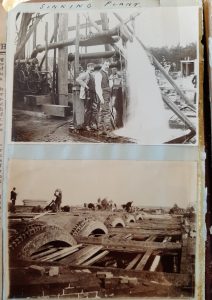
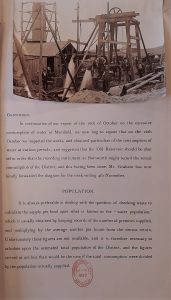
Leave a Reply